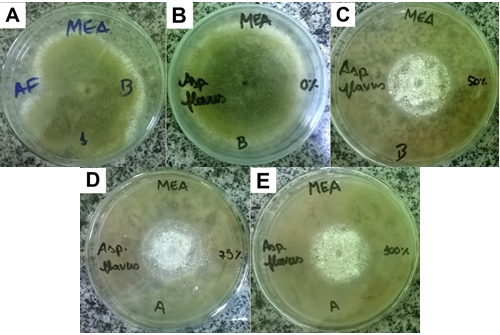Saccharomyces cerevisiae strain associated to a fish culture additive: antifungal activity and AFB1 adsorption potential
DOI:
https://doi.org/10.21708/avb.2021.15.1.9585Abstract
Saccharomyces cerevisae is widely applied as a probiotic in aquaculture activities, due to its ability to decontaminate the mycotoxin Aflatoxin B1 (AFB1). With this in mind, the aim of the present study was to evaluate the antifungal and anti-aflatoxigenic activities of inactivated Saccharomyces cerevisiae mixed with a commercial product (CP) of animal feed to assess its influence on the Aspergillus flavus and A. parasiticus fungi growth and on the AFB1 production. In addition, AFB1 adsorption potential of S. cerevisae and commercial product was also investigated. Different concentrations of commercial product alone and in the presence of inactivated yeast were analyzed by Aspergillus growth inhibition test, aflatoxin production by Aspergillus species and AFB1 adsorption capacity. AFB1 detection and quantification were carried out by High Performance Liquid Chromatography. The inactivated yeast and commercial product combination was effective in reducing A. flavus and A. parasiticus growth. A. flavus produced less AFB1 after the inactivated yeast treatment, whereas A. parasiticus produced significantly less AFB1 under a combination of inactivated yeast and 50% CP. Regarding AFB1 adsorption, 100% CP displayed the highest adsorption capacity at 10 ng mL-1 AFB1. At 25 ng mL-1 AFB1, only the treatment comprising inactivated yeast associated to 50% CP led to AFB1 adsorption, albeit at low levels.
Downloads

Downloads
Published
Issue
Section
License
Autores que publicam na Acta Veterinaria Brasilica concordam com os seguintes termos: a) Autores mantém os direitos autorais e concedem à revista o direito de primeira publicação, com o trabalho simultaneamente licenciado sob a Licença Creative Commons Attribution que permite o compartilhamento do trabalho com reconhecimento da autoria e publicação inicial nesta revista. b) Autores têm autorização para assumir contratos adicionais separadamente, para distribuição não-exclusiva da versão do trabalho publicada nesta revista (ex.: publicar em repositório institucional ou como capítulo de livro), com reconhecimento de autoria e publicação inicial nesta revista. c) Autores têm permissão e são estimulados a publicar e distribuir seu trabalho online (ex.: em repositórios institucionais ou na sua página pessoal) a qualquer ponto antes ou durante o processo editorial, já que isso pode gerar alterações produtivas, bem como aumentar o impacto e a citação do trabalho publicado (Veja O Efeito do Acesso Livre).


 Esta obra está licenciada com uma Licença
Esta obra está licenciada com uma Licença 